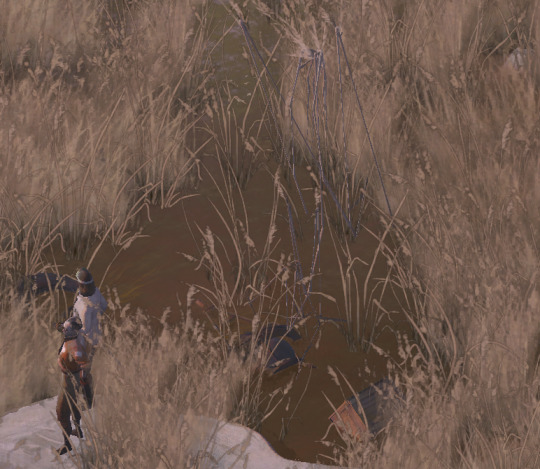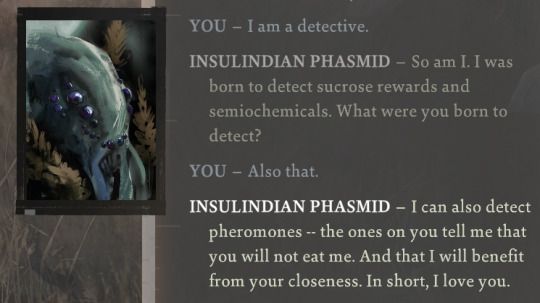#tate plays disco elysium
Explore tagged Tumblr posts
Text



I love you, Insulindian Phasmid...
(also only realized this second time around that you can see her standing in the reeds before you even talk to the deserter, and boy if that isn't spooky.)
#tate plays disco elysium#disco elysium#disco elysium spoilers#insulindian phasmid#sorry for shit quality high settings will kill my sad little laptop
63 notes
·
View notes
Text
My husband is playing disco Elysium for the first time and hasn’t discovered the protagonist’s name yet, so I said “have fun playing Tate McGee or Flix M’Tiddies” and he gave me an exasperated look and said “I don’t want any spoilers!”
4 notes
·
View notes
Text
The video game apocalypses are already here
Early on in the zombie film 28 Days Later, Cillian Murphy wanders out of hospital after waking from a month-long coma and crosses a deserted Westminster Bridge. The roads and pavements are empty and strewn with litter, all the while the gothic Palace of Westminster looms over the bewildered Murphy, now a sightseeing tourist in post-apocalyptic London. Understandably, there has always been a lot of interest in how this iconic scene was filmed. How was such a busy landmark in the capital entirely emptied of people? The answer was fairly simple: they filmed it at 5am on a Sunday in the middle of summer.
Today, there would be no need for such ingenuity. In the heat of a global pandemic, central areas of London are almost entirely abandoned (except on Thursdays when crowds congregate, zombie-like, to clap for carers on the very same bridge). Photographers from around the world have already been documenting cities under lockdown – a deserted Times Square, a lonely Eiffel Tower, a vacant Piccadilly Circus, its Coca-Cola billboard eerily replaced with the deadpan face of a monarch. It could be an image captured from the upcoming Watchdogs: Legion, or the location of a horrifying shoot-out in the new Call of Duty: Modern Warfare.
How quickly reality can be made to look like fiction. We’re used to seeing images of ruination and abandonment. There’s a long artistic tradition fascinated with crumbling visions. From European obsessions with classical antiquity to Romanticism’s love for gothic castles and abbeys. In games this enthusiasm plays out within the realms of the medieval fantasy epic – The Elder Scrolls, Dark Souls or The Witcher series’ many deteriorating structures often echo the work of 18th and 19th century painters like JMW Turner, Caspar David Friedrich or John Constable.
In 2014 the Tate Britain ran an exhibition entitled Ruin Lust, which is as apt a name as any for this seemingly innate desire to witness mournful kinds of destruction. More recently, we’ve become fascinated with modern, urban ruins. Culture has spent decades recovering from pictures of catastrophic devastation caused by the World Wars, and several more bracing itself for nuclear devastation. Slowly, decaying stone towers, ancient keeps and overgrown amphitheaters have been swapped out for bombed cities, abandoned factories, and rotting shopping malls.
Games are just as obsessed with representations of contemporary ruin, and there’s obviously a real pleasure to be found in exploring them. Take Fallout 76, a game whose greatest asset was always its environment: a detailed recreation of a West Virginia left behind. Its map is a patchwork of ruined modernity, all rusted mining facilities, luxury high-rises, highway mega stops and middle-class gallerias. Amongst the genuine Appalachian wilderness are various concrete flyovers and tarmac runways – the in between, suburban spaces that recall the drosscapes and edgelands of a J.G. Ballard novel. These are “large tracts of abused” and wasted land on the periphery: “contaminated industrial sites, mineral workings, garbage dumps, container stores, polluted river banks.” Whilst real landscapes may not have been razed by nuclear bombs, they are surely still contaminated.
The Division series is another game invested in this sort of apocalyptic imagery. Its abandoned New York and Washington, D.C has been overturned, not by zombies, but by a devastating pandemic. Quite uncannily, just as real banks are currently disinfecting their notes in fear of the coronavirus’ ability to persist on paper surfaces, the spread of The Division’s deadly pathogen is caused by this very phenomenon. The irony of a globe ravaged by a virus that attaches itself to capital – a sickness travelling on top of a sickness.
Outside of games there’s a boom in documenting all kinds of disintegrating architecture, a growing interest in things like ghost towns and unfinished structures, and even a rise in activities like rooftopping, skywalking and urban spelunking. Whilst intrepid urban explorers jump barriers and sift through reality’s ruins, games allow us to do something similar within increasingly sophisticated virtualities. And yet whilst the real world seems to be filled with opportunities to delve into and examine real ruins and zones of abandonment, games often tend towards fictional extremes. Try and count how many big-budget titles are future-orientated or out-right post-apocalyptic and you’ll quickly lose count. But what seems increasingly apparent – particularly amidst the ongoing pandemic, and widespread environmental collapse – is that for many of us the apocalypse has already arrived. To rejig an oft-quoted line from the father of cyberpunk, William Gibson: “the [apocalypse] is already here – it’s just unevenly distributed.”
We see urban destruction all around us in our daily lives. Another way of looking at all this ruination is as a continuation of Gothic aesthetics. Gothic art and literature was very much about how old, medieval forms were superseded by industrialisation, and how often these ancient things rise up and return to haunt us. Today, the process continues, except instead we are witnessing more industrial elements of capitalism being replaced by newer, more “advanced” post-industrial forms. Instead of ruined castles we get the shells of factories and derelict public housing. Instead of paintings of Tintern Abbey, we get haunting photographs of post-industrial Detroit.
We’re often dreaming of post-apocalypses, waiting for that big moment or cut-off point – for the bomb to drop. But ruins are all around us. Photographers like Matthew Christopher and Seph Lawless have spent years documenting contemporary ruins with their cameras. Christopher’s book series, Abandoned America, looks at a wide range of shattered dreams – everything from derelict schools and universities, to old hospitals and asylums, and even the shattered visages of humongous presidential busts. Seph Lawless has similarly recorded the slow ruination of American capitalism. His books on dilapidated theme parks and abandoned malls are the perfect environmental inspiration for video games. His ghostly images highlight the destructive, self-cannibalising energies of contemporary economic systems. As people like Dan Bell pick through the debris of shuttered shopping centres in his Dead Mall video series, we can begin to appreciate the fact that when even the greatest symbols of 20th century consumerism are left to rot, nothing is sacred.
When it’s not ruins left by American capitalism, it’s spectral images coming out of post-Soviet areas that catch our eye. One of the greatest game series involving urban exploration, STALKER, is based on the very real ruins that surround the Chernobyl Power Plant. Outside of this one specific zone, we see wreckage turned aesthetic in various “Cosmic Communist Constructions”, such as those photographed by Frédéric Chaubin or Rebecca Litchfield.
As time and history moves on, it doesn’t just produce physical ruin, but various ghosts and phantasms that seem to haunt our cultural imagination. Adventure games like Disco Elysium, Kentucky Route Zero and Night in the Woods have all been particularly successful in leaning into this idea of a contemporary Gothic. In Night in the Woods, the town of Possum Springs contains a number of boarded-up and closed-down stores. The game’s declining mall and disused rail system all stem from the loss of industry and severe economic depression. Likewise, the first act of Kentucky Route Zero has you exploring an abandoned mine, whilst Disco Elysium features areas like the Doomed Commercial Area, a shuttered factory, a derelict pier, and even an old ruined sea fort. Sometimes these places are physically haunted within the game’s fiction, other times there is simply an eerie absence of the human – the ghosts are all shattered dreams and failed utopias mixed up amidst the physical rubble.
We often hear about defunct things being assigned to the “garbage heap of history”, but the truth is history itself is one giant dustbin. We needn’t look to the far future to find striking examples of ruin, only to the past. All over the world there are structures abandoned or doomed to unfinished states. Take Hashima Island, perhaps most well known for its appearance in the James Bond film Skyfall. Commonly known as “Battleship Island”, the place was a centre of industrialisation (and forced labour) until its closure in the 70s. Other ghost towns like Varosha, an abandoned seaside quarter in the Cypriot city Famagusta, Fordlândia in the middle of the Amazon rainforest, and even Pripyat – a place we’re all exceptionally familiar with – show us what might be left behind when disaster strikes. We might also cast our eyes towards more modern ghost cities. Much has been made of places like Ordos, a modern metropolis that seemed to suddenly spring up from the deserts of China’s Inner Mongolia. Similarly, drone footage of incomplete luxury housing developments in Turkey, and the unfinished tower blocks of Iran’s Pardis (Paradise), are all evidence of the physical effects of ongoing economic crises.
As we hurtle towards the future, civilisation will no doubt accumulate even larger piles of physical rubbish. Our leftovers are already considerable, and we need never look far for it. There are abandoned pockets and ruined zones in each and every city in the world. And with evidence of the apocalypse all around us, it’s no wonder games both highlight this damage as well as take things to their logical extreme, where capital cities are entirely emptied and the planet is irreversibly scarred.
from EnterGamingXP https://entergamingxp.com/2020/05/the-video-game-apocalypses-are-already-here/?utm_source=rss&utm_medium=rss&utm_campaign=the-video-game-apocalypses-are-already-here
0 notes
Text
for some reason this hardcore run has been my best, most successful run of all the other times I've played disco elysium??
the most homoerotic, the most efficient, the most everything. what is happening.
#I'm on day 2 and#like I'm at the ruby bit and got Joyce to give up her info#earned the hardie boys about rhe tribunal#shot the body down and did such s thorough investigation first day that give was like “we did everything we could have and then some wow”#got the green ape pen#stole the raincoat#so much efficiency this time around and on hardcore mode of all things#even got the aces high AND aces low with kim so we are In Love eith his very specific +2 empathy bonus to him only#like man paid my room off both days and had EXTRA#never had a run go this well before#and of course it would be my the one time I'm regular boring honor law officialing my way through#I'm just a highly successful competent bisexual detective man with a tragic past that I deserve to grow from#also idc if I have to savescum this one thing bc I had to betray the cool poet lorry dude for this so I am NOT gonna let ruby kill herself#FOR THE COOL POET LORRY DRIVER#WHO SELLS OFFBRAND ADIDAS SLAV MERCH#tate talks#need to change that since new name#but w/e for now#tate plays disco elysium#disco elysium
13 notes
·
View notes